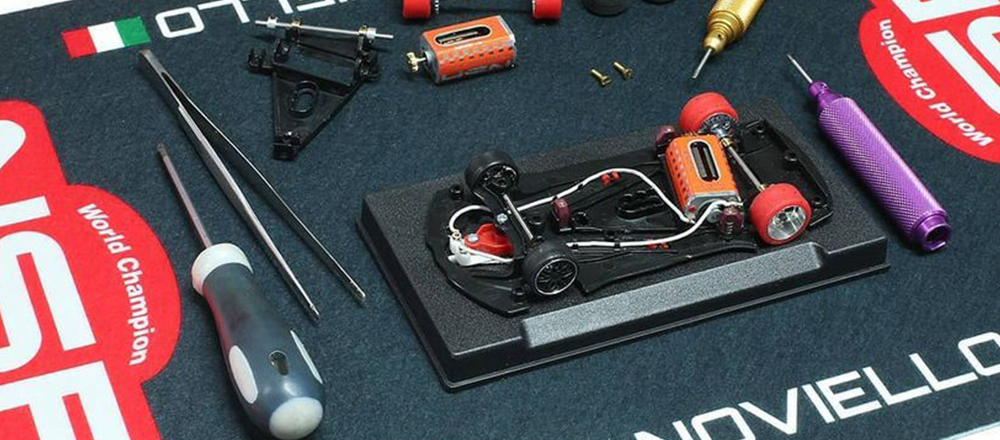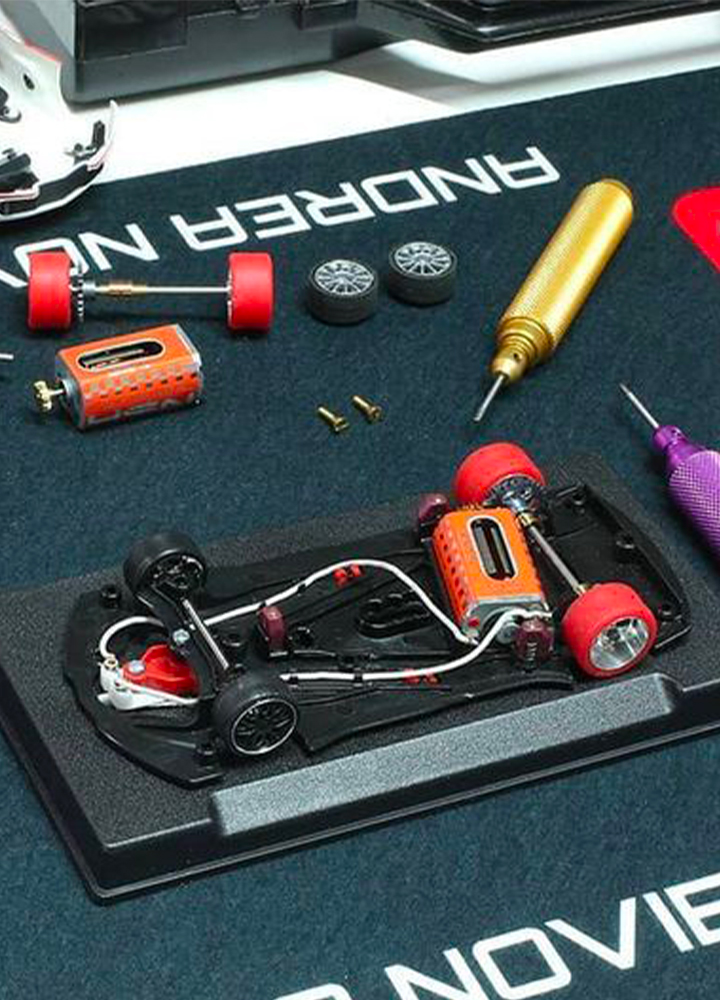
Slot car maintenance: key tips
Slot cars, although on a smaller scale than the cars we are used to driving, require careful care to maintain optimal performance and lasting enjoyment. In this detailed guide to slot car maintenance, we will explore the essential steps to clean, lubricate, replace worn components, and properly preserve your precious cars.
Video tutorial on slot car maintenance
Slot car maintenance tips 1: regular cleaning
Regular maintenance of your slot cars is essential to ensure optimal performance and prolong the life of your vehicles. However, it is good to remember that the tracks and tracks on which you race your creations should also be kept in optimal condition. Here, then, are some general steps you might consider:
- Track cleaning: slot car tracks can accumulate a lot of dust, dirt and oil over time. How can this be avoided? Clean the track regularly with a soft, clean cloth or a specific track cleaning product. Avoid the use of overly aggressive solvents that could damage the track surface.
- Tire cleaning: slot car tires can pick up debris from the track, affecting grip and, consequently, performance. Use a brush or compressed air tool to remove dust and debris from the tires.
- Cleaning the chassis and motor: clean the chassis and motor of the slot car to remove any residual oil and grease. You can use a clean, dry cloth or a cleaner specifically for electric motors. Be sure to do this carefully to avoid damage to electronic components.
- Controller maintenance: If you use a manual controller, check its condition periodically. Carefully clean the contact elements and make sure the cables are in good condition. When and if there are problems, it is best to get advice from an expert who will assess whether to proceed with maintenance or replacement of components. You should always remember that regardless of the slot car's performance, in cases where maintenance has not been done properly, you could get an electric shock or worse.
Maintenance tips 2: use of lubricant
The next step after thorough cleaning is component lubrication. It is critical to maintaining a smooth, friction-free ride. Apply a slot car-specific lubricant to moving parts, such as bearings and gears. Avoid excess lubricant, as it can attract dust and debris, impairing performance. Lubrication should be part of a larger maintenance routine. So organize a plan where, based on the use of the slot cars, you plan the care of your creations. Check the condition of moving parts regularly, watch for signs of wear, and replace lubricant when necessary.
A handy to do list for lubricating your slot cars
To avoid mistakes and forgetfulness, here is a handy to-do list:
- Choose and use a lubricant specifically for slot cars or model cars. These lubricants are designed to reduce friction and wear on moving parts without attracting excessive dust and dirt. Avoid using lubricants that are too thick or sticky, which could impair performance.
- Carefully apply lubricant in appropriate amounts. A small amount is often enough, and excess lubricant can attract (again!) dust and debris, causing problems instead of solving them. Concentrate on gears, bushings and other moving parts.
- The frequency with which to lubricate depends on the intensity of use. If you use slot cars regularly, you may need to lubricate more frequently. However, avoid overdoing it, as excess lubricant buildup can become counterproductive. Let's take an example: if you're used to running your slot cars once a week, let's say, on the weekend, it's good and proper to do a checkup after its use. If, on the other hand, you use them a couple of times a month, check every two weeks: even standing still, slot cars need to be taken care of!
- Before proceeding with new lubricant, remove any residue of old lubricant and clean the surfaces thoroughly. Preventive cleaning helps ensure that fresh lubricant is effective and that there are no unwanted particles between moving parts.
- Different parts of the slot car may require different types of lubricant. For example, gears may benefit from a thicker lubricant than bushings or plastic parts. Read the manufacturer's recommendations carefully and adjust lubrication to suit your slot car's specific needs. A good idea to keep in mind is to use silicone-based lubricants, which are ideal for slot cars because of their resistance to dust. Another idea is to use anti-corrosion oils to protect gears during extended periods of inactivity.
Slot car maintenance tips 3: when to replace components
Check your slot car parts regularly for signs of wear and tear. Replacing slot car parts may be necessary for a variety of reasons and often depends on the level of wear, damage, or any improvements you want to make to your vehicle. Obviously, before doing component replacement, it is always advisable to consult the manufacturer's manual for the slot car you want to work on. You need to check the specific instructions well to make sure the new parts are compatible with the model. Here is a handy list of cases where you may need to replace components:
- Over time, some slot car parts, such as tires, gears and bushings, can wear out due to friction and continued use. This is completely normal and is part of routine maintenance. When performance begins to decline or problems occur, replacement of these consumable parts may be necessary.
- Accidents or bumps can cause damage to slot car parts. Trivially, body parts can break, axles can bend, or gears can be damaged. A good practice is to have these types of parts on hand at all times. Let's think about a race. Exactly like the ferrari pit and the like, it is important to have someone who can step in in case of unforeseen problems.
- In some cases, it is advisable to replace components before obvious problems occur . For example, periodic replacement of gears or regular lubrication of moving parts can help prevent wear and tear and extend the life of components. Should problems arise that need to be fixed immediately, the advice is to always keep a set of spare parts on hand for quick and smooth maintenance.
Replacing components to improve our slot car
There are not only the cases when the slot car breaks down or gives problems. You can change components for other reasons as well:
- You may wish to improve the performance of their vehicle through the replacement of certain components. For example, you can install more powerful engines, tires with more grip, or upgrade the gears to achieve greater speed.
- Over time, new technologies and improvements in designs can make some slot car components obsolete. In such cases, replacement of specific parts may be necessary to keep the vehicle up to date with the latest innovations. Should this desire for innovation not arise because of an emotional issue with your slot car, don't worry: you don't have to give up something you care about just because "there's better." Try talking to an expert to find a common ground between innovative systems and the features of your slot car that you just don't want to give up.
- As mentioned earlier, slot car enthusiasts often customize their vehicles to make them unique. This might involve replacing components such as bodywork, tires, lights, or other accessories to create a more personalized model that suits your taste. The important thing is that you give room for your imagination and that the model "reflects you"-it should be a product of your ingenuity and creativity...with an eye always on constant maintenance. In this regard, take a look at the our body kit.
Maintenance tips 4: how to preserve your slot cars
When your slot cars are not in use, store them properly to avoid damage. We have seen that it is always necessary to do a good cleaning first. Use specially designed cases or containers to protect the cars from dust and accidental bumps. Store the cars in a cool, dry environment to prevent corrosion and deterioration.
Here are some tips for proper storage of your slot cars:
- Store slot cars in a controlled environment, preferably away from extreme temperatures and humidity. Avoid exposing models to direct sunlight, which may fade body colors and details.
- Use special cases or boxes to protect slot cars from dust. Transparent cases can be especially useful, as they allow you to view the model without having to handle it.
- Keep slot cars in a horizontal position, preferably with the wheels off the ground. This helps prevent tire deformation and maintain even weight distribution.
- Keep any manuals, instructions or original documentation with the slot cars. These documents may be useful for future reference or for any maintenance work.
- Even if slot cars are being stored, it is advisable to perform a periodic inspection. Check the condition of the batteries (if any), make sure there are no signs of corrosion or obvious damage, and take any preventive measures.
Maintenance tips 5: verification and calibration
After doing the previous steps properly and before each race or intensive driving session, always do a general check of the slot car and its calibration. Check the smoothness of the wheels, make sure the tires have sufficient grip on the track. Check the voltage of the brushes and the correct electrical connection. Also:
- If you use a hand controller, make sure it is calibrated correctly. Check the controller's response to lever changes and adjust the sensitivity or trigger travel to your preference.
- If your slot car is powered by batteries, check the charge of the batteries or replace them if necessary. Make sure the power system is working properly.
- Check the bodywork for any damage or deformation. Make sure it is securely attached to the frame and does not interfere with wheels or other moving parts.
- After verification and calibration, test the slot car on a track to make sure all the changes you have made have improved performance. Make any further adjustments according to your driving preferences.
Remember to refer to the manufacturer's manual for specific instructions on checking and calibrating your slot cars, as procedures may vary by model and brand. With all this done, you can confidently race your slot car model!
This article has a comment
Comments are closed.






Appreciate this post. Will try it out.